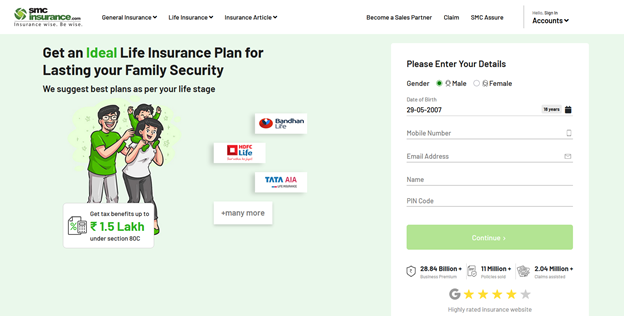Visit the SMC Website
-
Go to the official SMC Insurance website. Navigate to the Whole Life Insurance section. The interface is clean, intuitive, and designed to guide you, not overwhelm you.


Time Remaining to Avail Tax Benefits
(Under section 80C & 80D)
The Whole Life Insurance Plan, popularly known as Traditional or Permanent Life Insurance, offers comprehensive coverage for the insured's life, provided the premiums are paid every year. In addition, an individual with a Whole Life Insurance Plan can withdraw the policy anytime or even borrow against it.
The maturity for a Whole Life Insurance Plan is 100 years. However, the policy can be endowed upon maturity if the policyholder lives past the maturity period. It also offers tax-free death benefits to the insured and maturity and survival benefits.
The Whole Life Insurance Plan is tailored to help you create financial stability and also ensures that you remain covered for the rest of your life. According to an individual's need, they can choose any plan they wish to purchase, as Life Insurance Companies offer many policies.
Some of the amount from the premium paid by the customer is used to offer protection, and the rest remains with the company as an investment. The company also provides a bonus to the insured if profit is earned. The value of the amount invested grows. The policyholder can also choose to withdraw the policy.
The Whole Life Insurance Planline-wi comes with very distinctive features. It provides comprehensive life coverage to the insured. In case the insured is no more, the insurance amount goes to the nominee. Some of the Whole Life Insurance Plan features are as follows:
1
The premium insurance rate on this policy remains the same throughout the policy and does not fluctuate.
2
Whole life Insurance Policy is tailored to protect the family of the insured in the form of guaranteed payment and bonuses (if any).
3
The insurance company will pay the death benefit to the nominee in the event of the insured's untimely demise during the tenure of the policy. Upon payment of all premiums, the insurance company pays the death benefit as the sum assured amount to the beneficiary of the policy.
4
According to sections 80C and 10 (10D) of the Income Tax Act 1961, the premium paid towards the policy and maturity proceeds are tax exempted.
5
The plan offers a loan against the policy to the insured upon completion of 3 years.
It is recommended to contact your insurance provider for a better insight to choose the best plan from the different types of Whole Life Insurance Plan available. Before we delve into more detail of a whole life insurance plan, let’s understand some basic terms and how they can have an influence on the plan you choose.
Whole Life Insurance gives you lifelong protection, guaranteed returns, and potential bonuses. Let’s break down what you pay and what your family receives.
Whole Life premiums are higher than term plans. But you're not just buying protection, you are actually building wealth.
Factors That Affect Premiums:
For example,
A 30-year-old non-smoker might pay Rs. 45,000-Rs. 65,000 annually for Rs. 50 lakhs coverage (payable for 15 years). And after those 15 years? No premiums, just lifetime coverage.
Your nominee gets a guaranteed death benefit, plus any accrued bonuses (if applicable).
Payout Components:
Pro tip: A limited pay, participating plan can build strong cash value and serve as a fallback fund in emergencies.

The Whole Life Insurance Policy accumulates cash throughout the term, which helps the individual tackle any monetary issue in the future. Through this, a person can achieve their long-term goals in terms of finance.

Policy term is of 100 years, an individual can avail loan against the policy upon completion of 3 years. Also, the premiums need to be duly paid every year.

Whole Life Insurance Policy is the best plan if an individual wants to provide financial security and stability to their family and loved ones. It serves a great purpose in financial planning.

By taking the policy at a very young age, the premium's low cost is locked, so the policyholder does not have to pay a huge sum as a premium.

The term would end only after the policyholder's demise. In case of any illness or disease, the premium will not be cancelled. Hence, it gives lifetime coverage to the insured and their family (in the absence of the policyholder).
Life cannot always go as you predict it to, but your financial security can! Whether you're a young parent, a mid-career professional, or someone approaching retirement, Whole Life Insurance can serve as a steady pillar of protection and peace of mind not just for you, but also genuinely for the people you love most. But who really needs a Whole Life Insurance policy? Let’s get to that:
If you’re providing for young children or your elderly parents, a Whole Life plan ensures that your dependents won't be left financially stranded in the event of your untimely demise. From education expenses to daily living costs, this policy helps bridge the gap between tragedy and security.
Running your own business often means people depend on you - not just your family, but your employees too. A Whole Life policy offers long-term protection and can even be used as collateral for business loans. Furthermore, the policy's cash value may increase over time, giving your future planning more liquidity.
If you're in your 20s or 30s, locking in a Whole Life Insurance policy now means lower premiums and decades of growing cash value. It’s a disciplined savings plan in disguise, one that grows tax-deferred and can later be borrowed against.
For those looking to transfer wealth efficiently, Whole Life Insurance is often part of a larger estate planning strategy. It can cover estate taxes, ensuring your heirs receive what’s intended for them and not what’s left after taxation.
Term policies are temporary. Whole Life is forever. If your goal is lifelong peace of mind and you want your loved ones to receive a guaranteed payout no matter when you pass, this is the right fit for you.
In short, Whole Life Insurance is a valuable financial tool for anyone who wants to protect their legacy, provide stability for their family, and create long-term wealth.
Let us now take a look at the various types of whole life insurance plans and which one would work best for you.
A Whole Life Insurance Plan is categorized into five types:
Choosing a Whole Life Insurance plan is not a one-size-fits-all decision; it’s a long-term financial commitment that should align with your life goals, family needs, and appetite for risk. Here's what you should weigh before signing:
Are you looking for lifelong protection, a wealth-building tool, or both? Whole Life plans work well if you want to:
The sum assured should be sufficient enough to replace your income and meet long-term obligations. This is where you need to think about education, loans and inflation over 20-30 years.
Do you want to pay premiums till 60? Or wrap it up in 15 years and enjoy lifetime coverage? Whole Life policies offer limited pay options and they are perfect for those who want to finish payments early.
Add-ons like Accidental Death, Critical Illness, or Waiver of Premium can significantly enhance your plan’s scope, especially in case of life-altering events. Make sure to understand the terms, exclusions, and how the rider impacts your base policy
| Plans | Minimum & Maximum Age | Maturity Age | Policy Terms | Sum Assured |
|---|---|---|---|---|
| India First CSC Shubhlabh Plan | 18-55 Years | 65 Years | 10-15 Years | Depending On The Age Of The Insured |
| HDFC Life Sampoorn Samridhi Plus | 30-60 Years | 75 Years | 15-40 Years | Min: ₹1,00,000, Max: No Upper Limit |
| Bandhan Life iGuarantee Max Saving | 18-45 Years | 55 Years | 55 – Entry Age | Min: ₹1,00,000, Max: No Upper Limit |
| IDBI Federal Whole Life Insurance Plan | 30-60 Years | 100 Years | 100 Years | Depends On The Age Of The Insured, Max: No Upper Limit |
| Max Life Whole Life Super | 18-50 Years | 100 Years | Up to 100 Years of Age | Min: ₹50,000, Max: No Upper Limit |
| SBI Life – Shubh Nivesh | 18-60 Years | 100 Years | Up to 100 Years of Age | Min: ₹50,000, Max: No Upper Limit |
| TATA AIA Life Insurance Fortune Maxima | 30 Days - 60 Years | 100 Years | 100 - Entry Age (Single Pay) | Not Specified |
Now that you know the best plans available in the market today, let’s take a quick look at how you can pick the right one for your life needs.
Now that you know who should buy Whole Life Insurance, let’s talk about how to pick the right one:
Consider immediate expenses like utility bills, loan repayments, school fees, etc., as well as long-term needs such as college tuition or retirement support. Don’t forget to factor in inflation because an amount that feels big today may not be enough 10 years from now.
You’ll typically come across two types of Whole Life policies:
Participating Policies that share the insurer’s profits with you through bonuses/dividends and Non-Participating Policies that offer guaranteed, fixed benefits with generally lower premiums.
Riders are like power-ups for your base policy. Consider adding:
Whole Life policies often offer Limited Pay Options, meaning you pay premiums for a shorter time (say 10, 15, or 20 years), but enjoy coverage for life. Also consider your preferred payment frequency: monthly, quarterly, half-yearly, or annually and opt for what feels financially sustainable.
This is the person who will receive the policy payout. Whether it’s your spouse, children, parents, or siblings, make sure the nominee is someone who truly depends on your financial support. It is even possible to designate more than one nominee with a specific percentage split.
Don’t just pick the first plan you see. Compare different insurers based on:
A reputed insurer with excellent claim support can make all the difference when your family needs it the most.
Once you’ve selected a plan, review the benefit illustration i.e., a detailed document showing how your policy performs year after year. This includes:
And finally, always read the terms and conditions. The last thing you want is to be surprised by exclusions or limitations at the time of claim.
A Whole Life Insurance Plan is categorized into five types:

Let our experts guide you to the perfect choice!
Below are specific criteria that an individual needs to meet for applying the Whole Life Insurance Policy:-
However, the eligibility criteria differ according to the insurance company. Therefore, it is highly recommended to get in touch with the insurer directly to know more about the eligibility criteria.
Several Whole Life Insurance Policy calculators are available over the internet to help you calculate the premium and sum assured. However, to better calculate the term and the premium, contacting the insurance provider is the best option.
There is a vast difference between Whole Life Insurance and Term Insurance. An individual should be aware of the difference between the two before purchasing insurance. Some of the basic differences are as below:
| Points | Whole Life Insurance | Term Insurance |
|---|---|---|
| Aim | Insurance + Saving And Investment | Simple Life Insurance |
| Understanding | Comprehensive | Easy To understand |
| Premium Cost | High Premium | Low Premium |
| Premiums | Remain Same | Might Fluctuate |
| Renewability | No Need for Renewal | Need To Renew |
| Value Of Cash | Yes | No |
| Tenure | Lifetime | Fixed |
| Rider | Yes | No |
| Lapse | Does Not Lapse As Long The Premiums Are Duly Paid | Lapses If Not Renewed |
| Maturity Benefit | Yes | No |
| Death Benefit | Yes | Yes |
| Tax Benefit | Yes | No |
Forget about endless paperwork and aggressive agents because buying a Whole Life Insurance plan today is smart, simple, and 100% digital with SMC Insurance. Here's how to do it in just a few clicks:

View and compare policies from leading insurers like HDFC Life, ICICI Prudential, Tata AIA, and more. You’ll be able to see a detailed explanation of:
SMC gives you full transparency and no hidden details!
Need more clarity? Book a free call with an expert advisor - no pushy sales, just plain and unbiased guidance.
Once you decide on the plan that you need to buy:
Make a secure online payment and track your application status in real-time via SMS or email. And SMC handles everything else for you.
If you’re wondering why two people of the same age get different quotes, here’s the guide that drives the pricing:
Younger applicants get lower premiums because the risk to the insurer is lower. When you buy early, you lock in cheaper rates for life.
Smokers or individuals with risky habits like excessive alcohol consumption often face higher premiums.
Chronic conditions (like diabetes, hypertension, asthma) or hereditary diseases in the family may lead to premium loading, or even rejection in extreme cases.
The sum assured must be justifiable relative to your income as insurers want to ensure the cover isn’t high for your profile.
Every rider you include adds to the premium, but also to your peace of mind. Think of it like customising a car: more features, more cost.
Based on your age and disclosures, you may be asked to undergo tests like ECG, bloodwork, or even treadmill tests. These test results can also impact your quote.
A Whole Life Insurance policy is about locking in peace of mind for decades. The right plan will not only safeguard your family but also support you with a growing cash reserve over time. Because when it comes to life insurance, the best plan isn’t the cheapest. It’s the one that actually works when your family needs it most.
Yes, if you're looking for lifelong coverage with a built-in savings component. The cash value grows over time and can supplement your retirement income. But remember: it's more about protection with steady growth, not high returns like mutual funds.
Term insurance gives you pure protection for a limited period; no maturity or savings. Whole life insurance, on the other hand, offers lifelong coverage and cash value accumulation, making it a hybrid of insurance + investment.
Yes, once your policy builds up enough cash value, you can borrow against it, often at a lower interest rate than personal loans. However, unpaid loans reduce the final benefit.
It is the sum of money given to your designated beneficiary in the event that you pass within the policy's term. It comprises the sum assured as well as any bonuses or guaranteed additions, based on the plan.
Yes, but timing matters. If cancelled early, you might get little to no surrender value. Exiting after a few years may yield a portion of the accumulated value.
Many plans offer a grace period (usually 15-30 days). Beyond that, the policy may lapse or become a reduced paid-up policy and reviving it might require further medical checks.
If your policy builds sufficient cash value, yes, you can make partial withdrawals (in some plans) or take loans. But not all plans allow direct withdrawals, so it’s always advised to check the terms and conditions.
Yes, when you buy the plan, your premium amount stays fixed throughout the payment term.
The maturity and death benefits are usually tax-exempt under Section 10(10D), and cash value accumulation isn’t taxed annually. But tax regulations can change, so always consult your advisor.
Absolutely! Riders like Accidental Death, Critical Illness, or Waiver of Premium let you tailor your coverage. They offer extra protection without buying a separate plan.
Yes, most insurers let you add riders at the time of purchase. Some allow additions later too, but it may require underwriting.
It is simple. Just inform the insurer, submit the death certificate and policy documents, and complete the claim form. Once verified, the payout is processed, usually within 30 days.
By clicking I agree to all T&C